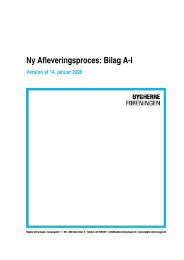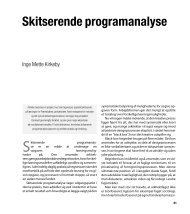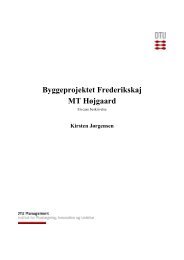Udvælgelses- dan og tildelingskriter ske byggesektor ... - RenProces
Udvælgelses- dan og tildelingskriter ske byggesektor ... - RenProces
Udvælgelses- dan og tildelingskriter ske byggesektor ... - RenProces
You also want an ePaper? Increase the reach of your titles
YUMPU automatically turns print PDFs into web optimized ePapers that Google loves.
186 A Diverse Understanding of Value in the Building Industry<br />
aspects of building are gathered in a product value paradigm. To fulfill the<br />
client’s reasonable needs and requirements, cooperation among the<br />
stakeholders in the building process is needed. The success of this<br />
cooperation process is highly dependent on the personal values of the<br />
participants and the common values of the project. The second paradigm<br />
is, therefore, the process values paradigm.<br />
1.4 THE SURVEY APPROACH<br />
It was decided to apply a survey approach to obtain a larger set of data. A<br />
survey was designed in order to investigate the hypothesis. The<br />
advantages of using surveys as a data collection method are mainly a fast<br />
and cost efficient way of collecting a rather large amount of data (de Vaus<br />
1993).<br />
The disadvantages are reported as, e.g. a possible low response rate<br />
(Delgado-Hernandez and Aspinwall 2005), lack of opportunity to clarify<br />
respondent doubts and no control over the speed with which participants<br />
return the completed questionnaires (Burns and Bush 2001). This was,<br />
however, taken into consideration when designing the questionnaire and<br />
when planning the data collection. It is, however, an accepted and<br />
widespread data collection method to such a kind of research in the<br />
building industry (Barrett and Lee 2004).<br />
1.4.1 Designing the Questionnaire<br />
An online survey tool (PHPSurveyor 2005) that could distribute the<br />
questionnaires by email and collect the data through a database solution<br />
on a webpage was used. The first step in designing the questionnaire was<br />
to choose which competes and variables that could support the<br />
investigation of the research hypothesis. In other words, a breakdown<br />
process from nominal variable to operational question was carried out. The<br />
final part of the breakdown was the actual questions written in the survey.<br />
Control over this structure was essential for making the analysis possible<br />
and hence receive reliable output from the analysis.<br />
A mixture of scales was utilized, i.e. nominal, ordinal, and interval<br />
scales. Predominant was the ordinal scale due to the intensive use of the<br />
Likert scale (Stevens 1946).<br />
One part of the questionnaire was designed to give information about<br />
the respondents’ basic data, i.e. dem<strong>og</strong>raphic variables. This part asks<br />
questions about the respondent’s company size and type. Furthermore, the<br />
respondent should answer in which ge<strong>og</strong>raphical area the company<br />
operates and whether the company had participated in any kind of<br />
development initiatives in the building industry. The second part of the<br />
questionnaire covered questions about variables concerning the<br />
respondent’s perception of the value concept. All questions were designed<br />
as 5-point Likert scales. In total, the questionnaire contained 15 questions,<br />
which makes it possible to complete the questionnaire within 10 minutes.<br />
186










